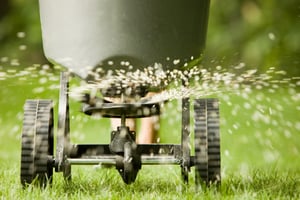 Spring typically conjures up images of running barefoot through the grass. But who wants to run barefoot or roll around in poison? True, we need to nurture our lawns if we want them to turn lush and verdant this spring, but we can add a boost of nutrients without chemicals that harm our pets and the environment. Check out these common chemicals to avoid in your lawn care routine.
Spring typically conjures up images of running barefoot through the grass. But who wants to run barefoot or roll around in poison? True, we need to nurture our lawns if we want them to turn lush and verdant this spring, but we can add a boost of nutrients without chemicals that harm our pets and the environment. Check out these common chemicals to avoid in your lawn care routine.
Glyphosate
This active ingredient found in many weed killers continues to get negative press. While the EPA has ruled it out as a carcinogen, the International Agency for Research on Cancer (IARC) disagrees. Glyphosate is excellent for killing weeds, but scientists say it can also destroy human cells and can cause changes in DNA and chromosomes. Glyphosate is so common that it’s also found in air and water samples all around the country. As an alternative, look for products that contain the words “natural” or “people safe.” You can also make your own weed killer with vinegar, salt, and dish soap.
Carbaryl
Carbaryl is a common chemical found in insecticides. Commonly sold as Sevin®. Many countries like Germany, the United Kingdom, and Sweden outlaw it because this chemical can kill a wide range of both good and bad insects. Carbaryl is great at lowering the mosquito population, but it also harms honey bees. Honey bees are crucial pollinators and an essential part of a healthy and robust environment. Using Carbaryl can affect your yard’s pollination as well as your local environment. Consider planting pest-repelling flowers and herbs to deter the mosquitoes and other garden bugs.
2,4-D
This widely used herbicide that kills weeds in the lawn is a popular lawn care product. 2,4-D, which stands for 2,4-dichlorophenoxyacetic acid, is an ingredient in many “weed and feed” lawn care products. This chemical has been linked to certain cancers and is one of the two main ingredients in Agent Orange. 2,4-D can also cause problems with the thyroid, reproductive system, hormones, and immune system.
Bifenthrin
This grub control product is good at limiting the number of insects on your lawn and plants. However, The Environmental Protection Agency lists the chemical as a possible carcinogen in humans. While some cities and counties use bifenthrin as a mosquito repellent while targeting the West Nile and Zika viruses, some parts of the country have banned the chemical. It’s especially dangerous around people with respiratory problems like asthma. Consider using a botanical insecticide containing citronella and pyrethrin (an ingredient naturally found in chrysanthemums). Better yet, plant chrysanthemums around the edge of your garden.
There are plenty of options when it comes to lawn care products. Many organic lawn care options are not only safe to use but also possess natural qualities that help to cut down on weed growth and pests. These are the most common chemicals to avoid in your lawn care routine. However, you’ll want to think twice and read the ingredients before using any chemicals around children or pets.
Do you have any tips you’d like to share? I’d love to hear them; please share them in the box below.
Author Bio: Jacob Palmer is a gardening and landscape design writer. When mowing lawns on his street as a child, he discovered a lifelong passion for landscape design. He now has three children who can all be found helping him most weekends with his next big garden project.





